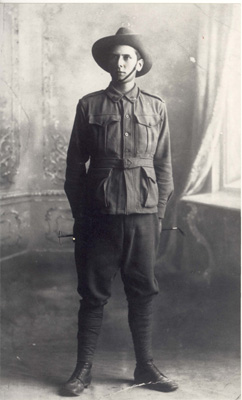PEARCE James Edward
-

- 950
- Private
- 41 Battalion
- Oakey Creek via Eumundi; Beerburrum Soldier Settlement (Maleny)
- Yes
- 1894
- 29 February 1916
- Demosthenes
- 18 May 1916
- Sydney NSW
-
The Chronicle 29 March 1918, p4 reports that Pte J Pearce is again in camp. [admin]
James enlisted in the 41st Battalion AIF at Brisbane 29 February 1916 He was described as being 5 feet 9 inches tall, weighed 151 pounds, of olive complexion, brown eyes, and dark hair and of the Church of England faith.
James was born at Mount Mee Queensland in 1894, the second youngest of eleven children of James Edward Pearce and Martha (nee Hewitt). On enlistment, James was aged 21 years and 6 months and had worked as a Teamster. He gave his next of kin as his mother, Martha Pearce, of Oakey Creek via Eumundi.
James embarked for overseas from Sydney on the ‘Demosthenes’ on 18 May 1916 to disembark at Plymouth England on 20 July 1916. Following further training, he proceeded to France from Southampton on 24 November 1916.
The 41st Battalion was raised at Bell’s Paddock in Brisbane and formed part of the 11th Brigade of the 3rd Australian Division. The Battalion entered the front line on Christmas Eve 1916 to spend a bleak winter alternating between service in the front line and training.
On 5 February 1917, James was evacuated from the field by the 9th Australian Field Ambulance to be admitted to 7 General Hospital suffering from Mumps. He returned to Base at St Omar on 24 February then rejoined the Battalion in the field on 28 February.
In March, the 41st Battalion relieved the 43rd in the Le Toquet sector extending from the River Lys in the south to Warnave River in the north. From the Unit Dairies of the 41st Battalion, we learn of the atrocious conditions the diggers faced with some trenches three to five deep with water.
By 1 April the Battalion was billeted at Le Bizet then marched to Ploegsteert Wood on 5 April. Here they occupied huts and farm buildings from where they provided support for the 42nd Battalion and then to relieve that Battalion in Ploegsteert-St Yves sector.
On 19 April, the 41st Battalion was relieved by the 43rd and marched to the Catacombs at Hyde Park corner, a large dugout cut and tunnelled into Hill 63. It contained accommodation for from 1600 – 2000 men with separate detached dug-outs for Officers, Mess, Orderly Room, Signal Box etc. with Cook Houses in the open on the side of the Hill. Here specialist training was undertaken.
By 1 June the 41st Battalion was billeted at Pont de Nieppe preparing for holding the St Yves sector from which, on 6 and 7 June, they came under continuous bombardment from the enemy including assault by gas, with both sides suffering casualties.
The 41st moved to Messines on 21 June 1917. From 1- 6 July the Battalion relieved the 43rd and took over the Front Line. Until the 11th July casualties were severe. It was here at Messines that James Pearce was wounded in action on 6 July 1917.
Having been admitted to the Casualty Clearing Station with gunshot wounds to both knees, James was then transferred to Hospital at Wimereux on 7 July. After a nine day hospitalisation in France, he was transferred to England to be admitted to Norfolk War Hospital, Norwich, on 17 July where he spent five weeks.
On 7 September, James was transferred to 3rd Auxiliary Hospital, Furlo Dartford until 25 October and then to convalesce at Sutton Veny from 8 November 1917 where he was classed B 1a2. He was reclassified as A 3 on 17 December and on 24 December, he ‘marched in’ from Sutton Veny to Long Deverell. A Medical Report of the wound to James’ right knee dated 5 January 1918, from Sandhill, described pain in the knee, swelling and tenderness. The Medical Officer recommended him to be fit for Home Service.
James ‘marched out’ to No.1 Commonwealth Depot at Sutton Veny on 7 January 1918, and classed C 1. Then on 19 January he ‘marched in’ from Sutton Veny to No. 4 Commonwealth Depot at Weymouth and on to No. 4 Commonwealth Depot at Hurdcott. From there James ‘marched out’ to Headquarters AIF Depot Tidworth on 11February 1918 where he was attached for duty with 41st Battalion. However, he was detached from duty on 8 March and ‘marched out’ to No 2 Commonwealth Depot (41st Battalion) and from there to Weymouth. On 25 April 1918 James embarked on the Hospital Ship ‘Suevic’ at Liverpool England for return to Australia.
Following his arrival at Melbourne on 6 June, James was transferred to 6 Australian General Hospital where he received further treatment for the gunshot wound to his right knee from 9 to 27 June 1918. A medical Report dated 25 June 1918 recommended James’ discharge as permanently unfit for General Service but fit for Home Service. James was finally discharged on 10 July 1918, one year after having been wounded on Active Service.
In 1920, James Pearce married Elsie Pickering, the daughter of Alfred Pickering and Emma (Hilder). For many years, the couple farmed at Eerwah Vale. James passed away in 1980 and is buried in Nambour Garden Cemetery.
- Messines
- 6 June 1918
- 1980
- Nambour Qld
- Nambour Garden Cemetery, Qld
-
Maroochy Shire Honor Roll, Shire Chambers, Bury Street, Nambour
Nambour (Maroochy Shire) Roll of Honor Scroll, Private Collection, Nambour (this scroll was available for sale to the public after the war)(on scroll twice)
Eumundi & District Roll of Honour Board, Eumundi Memorial School of Arts Hall, Memorial Drive, Eumundi
Kenilworth and District Honour Board, Kenilworth Community Hall
Kenilworth District Anzac Honor Roll, Gheerulla Hall
-
Digger's photo courtesy of Kenilworth & District Historical Museum.
Story provided by Betty Sutton.
Sources: NAA
AWM
Unit Dairies
Qld. BDMs
Family History - Betty Sutton
